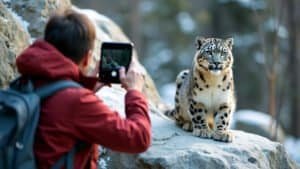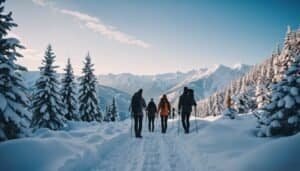Introduction
Tourism has emerged as a significant force in the fight to conserve the elusive and endangered snow leopard. By channeling revenues from ecotourism and other tourism-related activities into conservation efforts, these funds help protect snow leopard populations and their natural habitats
This article explores the various ways tourism revenues support snow leopard conservation projects, highlighting key initiatives, community involvement, challenges, and the importance of responsible tourism practices
Through a detailed examination, we uncover the critical role that tourism plays in ensuring the survival of this iconic species
How Tourism Revenues Directly Fund Snow Leopard Conservation
Tourism, particularly in regions where snow leopards roam, has become a crucial source of funding for conservation efforts aimed at protecting this elusive big cat. As tourism continues to grow in these remote mountainous areas, a significant portion of the revenue generated is funneled into various conservation projects
This financial support is essential, as it enables the implementation of on-the-ground initiatives that directly contribute to the preservation of snow leopard populations and their habitats
The Role of Ecotourism in Funding Conservation Efforts
Ecotourism is the backbone of conservation funding in snow leopard habitats. Unlike conventional tourism, ecotourism focuses on sustainable travel to natural areas, with an emphasis on conserving the environment and improving the well-being of local people
In regions like the Himalayas, Central Asia, and parts of Siberia, where snow leopards are native, ecotourism has become a vital economic activity. Tourists, attracted by the prospect of seeing these rare animals in the wild, are willing to pay a premium for eco-friendly tours
These tours often include guided treks, wildlife safaris, and cultural experiences, all designed to minimize environmental impact while maximizing economic benefits for conservation
The revenue from ecotourism is often reinvested in the local communities and conservation initiatives. For instance, funds are allocated to anti-poaching patrols, scientific research, and habitat restoration projects. These activities are crucial for monitoring snow leopard populations, protecting them from illegal hunting, and maintaining the integrity of their natural environments
According to a report by the Snow Leopard Trust, ecotourism has provided substantial funding for community-based conservation programs in countries like Mongolia and India, where local communities are directly involved in protecting snow leopards
Examples of Tourism Revenue Allocation in Snow Leopard Projects
Tourism revenues are strategically allocated to various conservation projects, ensuring that the funds are used effectively to protect snow leopards. For example, in India’s Spiti Valley, a portion of the income from tourism is directed towards the Snow Leopard Conservancy India Trust (SLC-IT)
This organization uses the funds to support community-led initiatives, such as the construction of predator-proof corrals, which reduce livestock losses and, consequently, human-wildlife conflict. By safeguarding livestock, these projects help foster positive attitudes towards snow leopard conservation among local herders, who might otherwise see the animals as a threat to their livelihood
In Mongolia, the Snow Leopard Conservation Foundation (SLCF) uses tourism revenue to support ranger programs. These rangers, often recruited from local communities, are trained to monitor snow leopard populations, track poachers, and protect critical habitats
The income from tourism not only funds these activities but also provides salaries for the rangers, making conservation a viable and respected profession in these remote areas
Another significant example is the “Himalayan Homestays” program, which operates in several snow leopard habitats across India and Nepal. This initiative, supported by tourism revenue, allows visitors to stay with local families, providing them with a direct source of income
In return, the communities commit to conserving snow leopard habitats and refraining from activities that could harm the species. The program has been praised for its dual benefits: preserving local culture and traditions while simultaneously protecting wildlife
Case Studies: Successful Tourism-Funded Conservation Initiatives
Several successful case studies highlight the impact of tourism revenues on snow leopard conservation. One notable example is the “Snow Leopard Enterprises” program in Mongolia, a community-based conservation initiative supported by the Snow Leopard Trust
The program involves local herders in the production of handicrafts, which are sold to tourists and international markets. In exchange, the herders agree to protect snow leopards and their prey species. The income generated from these crafts is significant, with a portion of the profits reinvested into local conservation efforts. Since its inception, the program has seen a marked reduction in poaching and retaliatory killings of snow leopards
Another case study is from the Kyrgyz Republic, where the “Biosphere Expeditions” program combines citizen science with tourism. Participants, who are mostly tourists, pay to join expeditions that involve tracking snow leopards, setting camera traps, and collecting data for scientific research
The revenue generated from these expeditions funds conservation projects, including the training of local rangers and the purchase of equipment for monitoring snow leopards. This initiative not only raises funds but also increases global awareness about the plight of snow leopards, as participants often share their experiences and findings with broader audiences
Key Conservation Projects Supported by Tourism Revenues
Tourism revenues provide critical financial resources for a variety of conservation projects that are essential to the survival of snow leopards. These projects cover a broad range of activities, from anti-poaching measures to habitat preservation and community education
By channeling funds into these initiatives, tourism not only supports the protection of snow leopards but also fosters a greater understanding and appreciation of the species among local populations and visitors alike
Anti-Poaching Patrols and Surveillance
One of the most significant threats to snow leopards is poaching, driven by the demand for their pelts and bones in illegal wildlife trade. Tourism revenues are instrumental in funding anti-poaching patrols and surveillance operations in snow leopard habitats
These patrols are often carried out by trained rangers who monitor known poaching hotspots, track illegal activities, and apprehend poachers. The presence of regular patrols acts as a strong deterrent to poachers, reducing the likelihood of snow leopard killings
For example, in Kyrgyzstan, the proceeds from eco-tourism have been used to establish a network of community-based anti-poaching units known as the “Snow Leopard Brigades”
These units are composed of local volunteers who are trained and equipped to patrol critical snow leopard habitats. Supported by organizations such as the Snow Leopard Trust and Panthera, these brigades have been effective in reducing poaching incidents by more than 50% in key areas
In addition to ground patrols, tourism revenues also fund the deployment of technology-based surveillance methods. Camera traps, drones, and satellite collars are increasingly used to monitor snow leopard populations and track their movements
This technology not only helps in understanding the behavior and ecology of snow leopards but also provides crucial data for conservation planning. The Snow Leopard Trust, for instance, has used tourism-generated funds to purchase and maintain camera traps across several snow leopard ranges, leading to better protection and scientific insights
Habitat Preservation and Restoration
Snow leopards inhabit some of the most rugged and remote mountain ranges in the world, including the Himalayas, the Altai Mountains, and the Tibetan Plateau
The preservation and restoration of these habitats are vital for the survival of the species, as they provide the necessary environment for hunting, breeding, and shelter. Tourism revenues play a crucial role in funding projects aimed at maintaining and restoring these habitats
One key area of focus is the prevention of habitat degradation due to overgrazing by livestock, which can lead to the depletion of prey species that snow leopards rely on
Tourism funds have been used to implement grazing management programs, where herders are provided with alternative livelihoods or compensated for reducing their livestock numbers. In Ladakh, India, for instance, tourism-related income has supported the establishment of livestock-free zones, allowing vegetation and prey populations to recover, thereby enhancing the habitat for snow leopards
Another important initiative funded by tourism revenues is the reforestation of degraded areas within snow leopard habitats. In some regions, the planting of native trees and shrubs has helped to restore the natural landscape, providing better cover and hunting grounds for snow leopards
These reforestation projects are often carried out in collaboration with local communities, who benefit from the employment and income generated by these activities
Community Education and Awareness Programs
Community education and awareness are fundamental components of snow leopard conservation, as local populations are the stewards of the environments where these big cats live
Tourism revenues are frequently allocated to educational programs that aim to increase understanding and support for snow leopard conservation among local residents, particularly in areas where human-wildlife conflict is prevalent
In Nepal, for example, the Annapurna Conservation Area Project (ACAP) uses funds from tourism permits and fees to run school programs and community workshops focused on snow leopard conservation
These programs teach the importance of biodiversity, the ecological role of snow leopards, and practical ways to coexist with wildlife. By fostering a sense of pride and ownership in conservation efforts, these educational initiatives help to reduce incidents of retaliation against snow leopards and promote long-term sustainability
Additionally, tourism revenues support the production of educational materials, such as brochures, documentaries, and exhibits in visitor centers, which are designed to inform tourists and locals alike about snow leopard conservation. These materials often highlight the cultural significance of snow leopards and the ecological importance of preserving their habitats
The Snow Leopard Conservancy’s “Living with Leopards” initiative, for instance, has produced a series of educational videos funded by tourism income, which are used in community outreach programs across snow leopard range countries
Community-Based Tourism and Its Impact on Snow Leopard Conservation
Community-based tourism (CBT) has emerged as a vital strategy in snow leopard conservation, linking the economic well-being of local communities with the protection of these endangered cats
By involving local people in tourism activities, these initiatives create economic incentives for conservation and foster a sense of ownership and responsibility for the preservation of snow leopards and their habitats
Involving Local Communities in Conservation Efforts
The success of community-based tourism in snow leopard conservation hinges on the active involvement of local communities. In many snow leopard habitats, the livelihoods of local people are closely tied to the land, and their activities can have a significant impact on the environment
By integrating local communities into the tourism sector, conservation organizations can encourage practices that support snow leopard conservation while providing alternative sources of income
In Ladakh, India, for example, the Snow Leopard Conservancy India Trust (SLC-IT) has pioneered initiatives that involve local communities in ecotourism. Villagers are trained as guides, homestay operators, and wildlife spotters, allowing them to benefit directly from tourism
In return, these communities commit to conservation efforts, such as refraining from hunting snow leopards or their prey, and participating in habitat restoration projects. This approach not only enhances the economic resilience of these communities but also strengthens their role as stewards of the environment
Similarly, in Mongolia, community-based tourism initiatives supported by the Snow Leopard Trust have empowered local herders to participate in snow leopard conservation. By hosting tourists, these herders generate income that supplements their traditional livelihoods
In exchange, they agree to protect snow leopards, contributing to monitoring efforts and helping to prevent poaching. This model of conservation is particularly effective because it aligns the interests of local people with the goals of snow leopard preservation, ensuring long-term sustainability
Economic Benefits for Locals Through Sustainable Tourism
The economic benefits of community-based tourism are a powerful incentive for local people to engage in conservation activities. Tourism provides a diversified income stream, reducing the community’s dependence on practices that might harm snow leopards, such as overgrazing or retaliatory killings
In areas where snow leopards are found, the presence of tourists creates new opportunities for income generation, from guiding and hospitality services to the sale of handicrafts and local products
The “Himalayan Homestays” program is a prime example of how sustainable tourism can transform local economies. Operated in regions like Ladakh and Spiti, this program allows tourists to stay with local families in traditional homes
The income from these homestays provides a substantial financial boost to families who might otherwise struggle to make a living in these harsh environments. As a result, these communities are less likely to engage in activities that could threaten snow leopard populations. The success of this program has been widely recognized, and it serves as a model for similar initiatives in other snow leopard range countries
In addition to direct income from tourism, community-based tourism initiatives often lead to broader economic development. Infrastructure improvements, such as better roads, communication networks, and healthcare facilities, are frequently funded by tourism revenues
These developments not only enhance the quality of life for local residents but also create a more attractive environment for tourists, creating a positive feedback loop that further supports conservation
Success Stories of Community-Led Tourism Initiatives
Several success stories demonstrate the impact of community-based tourism on snow leopard conservation. In the Wakhan Corridor of Afghanistan, a region home to a small population of snow leopards, the Wildlife Conservation Society (WCS) has partnered with local communities to develop ecotourism opportunities
By training local people as wildlife guides and establishing community-managed guesthouses, WCS has helped create a tourism industry that directly benefits local residents. This initiative has not only provided much-needed income but has also fostered a strong sense of pride in the region’s natural heritage, leading to greater efforts to protect snow leopards and other wildlife
Another notable example comes from the Chitral District in Pakistan, where the Snow Leopard Foundation (SLF) has worked with local communities to develop a sustainable tourism model
The SLF supports local artisans in producing and selling traditional crafts to tourists, with the proceeds funding community development projects and conservation activities. This initiative has successfully reduced human-wildlife conflict, as the income from tourism has decreased the reliance on livestock, which are often preyed upon by snow leopards
In Tajikistan, the “Pamirs Eco-Cultural Tourism Association” (PECTA) has developed a network of community-based tourism enterprises across the Pamir Mountains. These enterprises provide a range of services to tourists, including guided treks, cultural tours, and homestay accommodations
The revenue generated supports local communities and funds conservation efforts, such as the monitoring of snow leopard populations and the implementation of anti-poaching measures. The success of PECTA has led to increased community engagement in conservation, with many locals now playing an active role in protecting snow leopards and their habitats
Challenges and Solutions in Tourism-Funded Conservation
While tourism can provide essential financial support for snow leopard conservation, it also presents unique challenges
Balancing the needs of conservation with the demands of the tourism industry requires careful management to ensure that the benefits outweigh the potential negative impacts. Addressing these challenges is crucial for the long-term success of tourism-funded conservation efforts
Managing Tourist Footfall in Fragile Habitats
One of the primary challenges in tourism-funded conservation is managing the number of tourists visiting snow leopard habitats. These areas are often remote and ecologically sensitive, with fragile ecosystems that can be easily disturbed by human activity
High tourist footfall can lead to habitat degradation, pollution, and disruption of local wildlife, including snow leopards and their prey
To mitigate these impacts, many conservation organizations and local governments have implemented strict regulations on tourism in snow leopard habitats. For example, in the Hemis National Park in Ladakh, India, which is a key snow leopard habitat, the number of tourists is controlled through permits and designated trekking routes
Tour operators are required to follow specific guidelines to minimize their environmental impact, such as using eco-friendly camping practices, properly disposing of waste, and maintaining a safe distance from wildlife
In addition to regulating tourist numbers, conservationists are exploring ways to spread the impact of tourism more evenly across regions. By promoting lesser-known destinations within snow leopard ranges, they aim to reduce the pressure on more popular areas
This approach not only helps protect sensitive habitats but also encourages the development of sustainable tourism in new areas, providing economic benefits to additional communities
Balancing Conservation and Commercial Interests
Another significant challenge is finding the right balance between conservation goals and the commercial interests of the tourism industry. Tourism operators often prioritize profit, which can sometimes lead to practices that are detrimental to snow leopard conservation
For example, there is a risk that tourism activities could become overly commercialized, with a focus on maximizing tourist numbers at the expense of environmental and conservation concerns
To address this issue, partnerships between conservation organizations and tourism operators are crucial. These partnerships can help align the goals of conservation and tourism, ensuring that commercial activities support, rather than undermine, conservation efforts
In Kyrgyzstan, for instance, the Snow Leopard Trust has collaborated with local tour operators to develop eco-friendly tourism packages that emphasize the conservation of snow leopards. These packages include educational components, such as talks by conservation experts and visits to community conservation projects, helping to raise awareness among tourists about the importance of protecting snow leopards
Moreover, certification programs for sustainable tourism, such as the Global Sustainable Tourism Council (GSTC) standards, can play a key role in promoting responsible practices
These programs provide guidelines for tourism operators to minimize their environmental impact and contribute to conservation efforts. By obtaining such certifications, tourism businesses can differentiate themselves in the market, attracting environmentally conscious travelers while supporting snow leopard conservation
Addressing Seasonal Fluctuations in Tourism Revenue
Tourism in snow leopard habitats is often highly seasonal, with visitor numbers peaking during certain times of the year, such as the summer trekking season in the Himalayas
These seasonal fluctuations in tourism revenue can pose a challenge for conservation projects, which require consistent funding throughout the year to be effective
To address this issue, conservation organizations are exploring ways to diversify income sources and reduce dependence on seasonal tourism revenue. One approach is to develop year-round tourism activities that attract visitors during the off-season. For example, winter tourism, such as snow leopard tracking expeditions, is becoming increasingly popular in regions like Ladakh and Mongolia
These expeditions not only provide additional income for conservation efforts but also offer tourists a unique opportunity to observe snow leopards in their natural habitat during the winter months
Another strategy is to establish alternative funding mechanisms that complement tourism revenue. This can include donations from tourists, corporate sponsorships, and grants from conservation foundations. By diversifying their funding sources, conservation organizations can ensure a more stable and reliable flow of resources to support their work, even during periods of low tourist activity
Finally, long-term planning and financial management are essential for dealing with the seasonal nature of tourism. Conservation organizations must carefully budget and allocate funds to ensure that critical activities, such as anti-poaching patrols and habitat restoration, can continue uninterrupted throughout the year
By building financial reserves during peak tourist seasons, these organizations can buffer against the leaner months and maintain the continuity of their conservation efforts
Promoting Responsible Tourism in Snow Leopard Habitats
Responsible tourism is essential for ensuring that the presence of visitors in snow leopard habitats contributes positively to conservation efforts rather than causing harm
Promoting responsible tourism involves educating tourists, training tour operators, and fostering collaborations between conservation organizations and the tourism industry
These efforts help to minimize the environmental impact of tourism while maximizing its benefits for snow leopard conservation
Guidelines for Tourists to Minimize Environmental Impact
Educating tourists about responsible behavior in snow leopard habitats is a critical component of promoting sustainable tourism. Tourists often visit these remote areas to experience the pristine natural environment and catch a glimpse of the elusive snow leopard
However, without proper guidance, their activities can unintentionally harm the very ecosystems they came to enjoy
To minimize their environmental impact, tourists are encouraged to follow specific guidelines, such as staying on designated trails, avoiding disturbing wildlife, and adhering to “leave no trace” principles
These guidelines help protect snow leopard habitats by reducing habitat disturbance and preventing littering, which can attract scavengers and disrupt the natural balance
Many conservation organizations provide educational materials to tourists before their visit, either through websites, brochures, or orientation sessions conducted by local guides
For example, the Snow Leopard Conservancy provides detailed information on how to behave in snow leopard habitats, including advice on how to safely observe wildlife without causing stress to the animals. Tourists are also encouraged to support eco-friendly accommodations and services that prioritize sustainability and conservation
Additionally, tourists are advised to choose tour operators that are committed to responsible tourism practices. These operators typically have policies in place to reduce their environmental footprint, such as using renewable energy, minimizing waste, and ensuring that their activities do not disrupt local wildlife
By choosing responsible operators, tourists can make a positive contribution to snow leopard conservation while enjoying their travel experience
Training Programs for Guides and Tour Operators
Tour guides and operators play a crucial role in shaping the tourism experience and ensuring that it aligns with conservation goals. Proper training is essential for these individuals to effectively manage tourists, protect the environment, and promote snow leopard conservation
Training programs for guides and operators focus on a range of topics, from wildlife ecology and conservation practices to customer service and sustainable tourism principles
In snow leopard habitats, specialized training programs have been developed to equip local guides with the knowledge and skills needed to lead responsible tours. These programs often cover the natural history of snow leopards, the importance of their conservation, and best practices for minimizing human impact on the environment
For instance, in Nepal, the Annapurna Conservation Area Project (ACAP) offers training courses for local guides, emphasizing the importance of snow leopard conservation and sustainable tourism practices. Graduates of these programs are better prepared to educate tourists, manage their groups, and contribute to the protection of snow leopards
Tour operators also benefit from training that helps them develop and market sustainable tourism packages. These packages often include eco-friendly accommodations, wildlife-friendly activities, and opportunities for tourists to engage with local conservation efforts
Operators who participate in such training programs are more likely to adopt practices that align with conservation objectives, ensuring that their businesses support, rather than undermine, snow leopard conservation
Collaborations Between NGOs and Tourism Agencies
Collaborations between non-governmental organizations (NGOs) and tourism agencies are essential for promoting responsible tourism in snow leopard habitats. These partnerships leverage the strengths of both sectors: NGOs bring expertise in conservation and community engagement, while tourism agencies offer insights into market trends and visitor management
Together, they can create tourism models that benefit local communities, protect the environment, and ensure the sustainability of snow leopard conservation efforts
One successful example of such collaboration is the partnership between the Snow Leopard Trust and local tourism operators in Mongolia. This partnership has led to the development of community-based tourism initiatives that not only generate income for local herders but also promote conservation education among tourists
By working together, the Snow Leopard Trust and tourism operators have created a model where tourism directly supports snow leopard conservation, with a portion of the proceeds from tours going towards funding anti-poaching patrols and habitat preservation projects
In India, the collaboration between the Snow Leopard Conservancy India Trust (SLC-IT) and local tourism businesses has resulted in the establishment of the Himalayan Homestays program
This initiative provides tourists with authentic cultural experiences while ensuring that the revenue generated is reinvested in conservation and community development. The success of this program has demonstrated the potential of tourism to create sustainable livelihoods for local people while contributing to the long-term protection of snow leopards
Moreover, international partnerships between NGOs, tourism organizations, and government bodies can help standardize responsible tourism practices across snow leopard range countries
Initiatives such as the Global Snow Leopard & Ecosystem Protection Program (GSLEP) bring together stakeholders from different sectors to develop guidelines and strategies for promoting sustainable tourism. By fostering collaboration at both local and global levels, these initiatives ensure that tourism remains a positive force for snow leopard conservation
Conclusion
Tourism plays a crucial role in supporting snow leopard conservation by providing much-needed financial resources, engaging local communities, and promoting sustainable practices
Through direct funding, tourism revenues support key conservation projects, such as anti-poaching patrols, habitat restoration, and community education programs. Community-based tourism initiatives, in particular, have demonstrated how local involvement can lead to successful conservation outcomes, as these programs align economic incentives with the protection of snow leopards
However, the benefits of tourism must be carefully managed to avoid negative impacts on the fragile ecosystems where snow leopards live
Responsible tourism practices, supported by collaborations between NGOs, tourism agencies, and local communities, are essential for ensuring that tourism contributes positively to conservation efforts. By following sustainable guidelines, training local guides, and fostering partnerships, tourism can continue to be a powerful tool in the fight to preserve snow leopards for future generations










